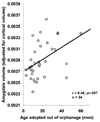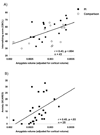Prolonged institutional rearing is associated with atypically large amygdala volume and difficulties in emotion regulation
- PMID: 20121862
- PMCID: PMC2817950
- DOI: 10.1111/j.1467-7687.2009.00852.x
Prolonged institutional rearing is associated with atypically large amygdala volume and difficulties in emotion regulation
Abstract
Early adversity, for example poor caregiving, can have profound effects on emotional development. Orphanage rearing, even in the best circumstances, lies outside of the bounds of a species-typical caregiving environment. The long-term effects of this early adversity on the neurobiological development associated with socio-emotional behaviors are not well understood. Seventy-eight children, who include those who have experienced orphanage care and a comparison group, were assessed. Magnetic resonance imaging (MRI) was used to measure volumes of whole brain and limbic structures (e.g. amygdala, hippocampus). Emotion regulation was assessed with an emotional go-nogo paradigm, and anxiety and internalizing behaviors were assessed using the Screen for Child Anxiety Related Emotional Disorders, the Child Behavior Checklist, and a structured clinical interview. Late adoption was associated with larger corrected amygdala volumes, poorer emotion regulation, and increased anxiety. Although more than 50% of the children who experienced orphanage rearing met criteria for a psychiatric disorder, with a third having an anxiety disorder, the group differences observed in amygdala volume were not driven by the presence of an anxiety disorder. The findings are consistent with previous reports describing negative effects of prolonged orphanage care on emotional behavior and with animal models that show long-term changes in the amygdala and emotional behavior following early postnatal stress. These changes in limbic circuitry may underlie residual emotional and social problems experienced by children who have been internationally adopted.
Figures






Similar articles
-
Biological substrates of emotional reactivity and regulation in adolescence during an emotional go-nogo task.Biol Psychiatry. 2008 May 15;63(10):927-34. doi: 10.1016/j.biopsych.2008.03.015. Biol Psychiatry. 2008. PMID: 18452757 Free PMC article.
-
Elevated amygdala response to faces following early deprivation.Dev Sci. 2011 Mar;14(2):190-204. doi: 10.1111/j.1467-7687.2010.00971.x. Dev Sci. 2011. PMID: 21399712 Free PMC article.
-
A functional and structural study of emotion and face processing in children with autism.Psychiatry Res. 2009 Sep 30;173(3):196-205. doi: 10.1016/j.pscychresns.2008.08.005. Epub 2009 Aug 8. Psychiatry Res. 2009. PMID: 19665877 Free PMC article.
-
Sensitive Periods of Emotion Regulation: Influences of Parental Care on Frontoamygdala Circuitry and Plasticity.New Dir Child Adolesc Dev. 2016 Sep;2016(153):87-110. doi: 10.1002/cad.20166. New Dir Child Adolesc Dev. 2016. PMID: 27589500 Review.
-
Limbic changes identified by imaging in bipolar patients.Curr Psychiatry Rep. 2008 Dec;10(6):505-9. doi: 10.1007/s11920-008-0080-8. Curr Psychiatry Rep. 2008. PMID: 18980734 Review.
Cited by
-
Early life adversity reduces affiliative behavior with a stressed cagemate and leads to sex-specific alterations in corticosterone responses in adult mice.Horm Behav. 2024 Feb;158:105464. doi: 10.1016/j.yhbeh.2023.105464. Epub 2023 Dec 8. Horm Behav. 2024. PMID: 38070354 Free PMC article.
-
Overlapping Neurobiological Substrates for Early-Life Stress and Resilience to Psychosis.Biol Psychiatry Cogn Neurosci Neuroimaging. 2021 Feb;6(2):144-153. doi: 10.1016/j.bpsc.2020.09.003. Epub 2020 Sep 10. Biol Psychiatry Cogn Neurosci Neuroimaging. 2021. PMID: 33097471 Free PMC article. Review.
-
Postnatal maternal distress, infant subcortical brain macrostructure and emotional regulation.Psychiatry Res Neuroimaging. 2023 Jan;328:111577. doi: 10.1016/j.pscychresns.2022.111577. Epub 2022 Dec 5. Psychiatry Res Neuroimaging. 2023. PMID: 36512951 Free PMC article.
-
Leveraging translational neuroscience to inform early intervention and addiction prevention for children exposed to early life stress.Neurobiol Stress. 2018 Oct 26;9:231-240. doi: 10.1016/j.ynstr.2018.10.004. eCollection 2018 Nov. Neurobiol Stress. 2018. PMID: 30450387 Free PMC article. Review.
-
Effects of early adversity on the brain: Larger-volume anterior cingulate cortex in AIDS orphans.PLoS One. 2019 Jan 14;14(1):e0210489. doi: 10.1371/journal.pone.0210489. eCollection 2019. PLoS One. 2019. PMID: 30640928 Free PMC article.
References
-
- Achenbach TM. Integrative Guide to the 1991 CBCL/4–18, YSR, and TRF Profiles. Burlington, VT: University of Vermont, Department of Psychology; 1991.
-
- Ames E. Spitz revisited: A trip to Romanian "orphanages". Canadian Psychological Association Developmental Psychology Section Newsletter. 1990;9:8–11.
-
- Ames E. The development of Romanian orphan-age children adopted to Canada (final report to the National Welfare Grants Program: HUman Resources Development Canada) Burnaby, BC: Simon Fraser University; 1997.
-
- Barros-Loscertales A, Meseguer V, Sanjuan A, Belloch V, Parcet MA, Torrubia R, Avila C. Behavioral Inhibition System activity is associated with increased amygdala and hippocampal gray matter volume: A voxel-based morphometry study. Neuroimage. 2006;33(3):1011–1015. - PubMed
Publication types
MeSH terms
Grants and funding
LinkOut - more resources
Full Text Sources
Medical
Miscellaneous

